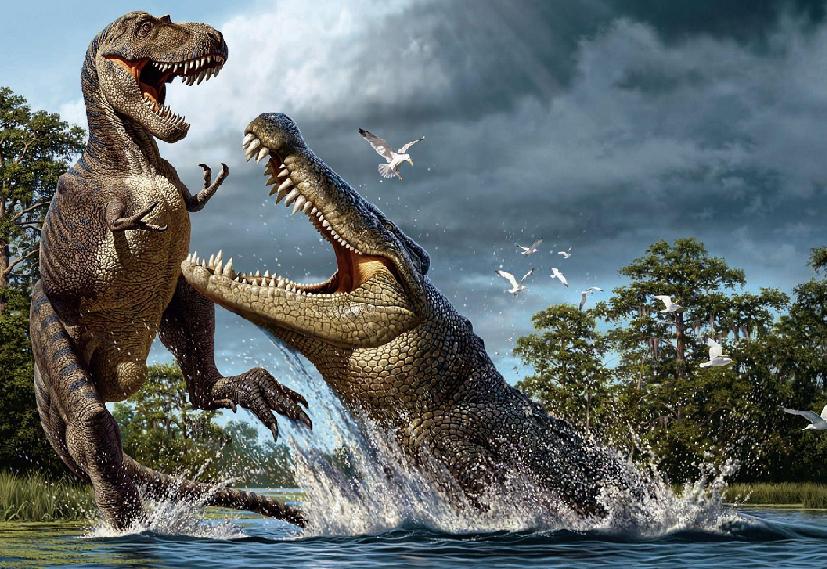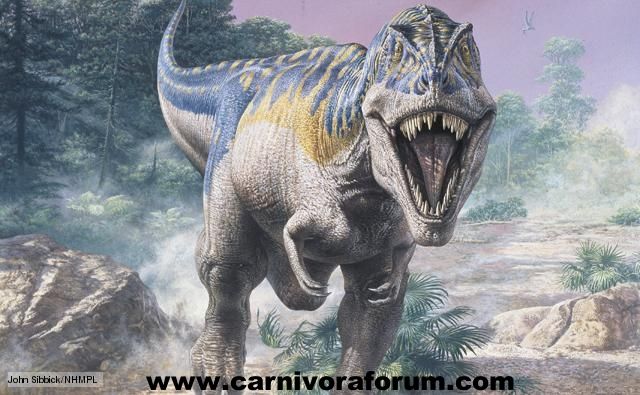Post by dinosauria101 on Feb 20, 2019 2:58:16 GMT 5
Deinosuchus rugosus
Deinosuchus is an extinct genus related to the alligator that lived 73 to 80 Ma (million years ago), during the late Cretaceous period. The name translates as "terrible crocodile" and is derived from the Greek deinos (δεινός), "terrible", and soukhos (σοῦχος), "crocodile". The first remains were discovered in North Carolina (United States) in the 1850s; the genus was named and described in 1909. Additional fragments were discovered in the 1940s and were later incorporated into an influential, though inaccurate, skull reconstruction at the American Museum of Natural History. Knowledge of Deinosuchus remains incomplete, but better cranial material found in recent years has expanded scientific understanding of this massive predator. Although Deinosuchus was far larger than any modern crocodile or alligator—measuring up to 12 m (39 ft) and weighing up to 8.5 metric tons (9.4 short tons)—in overall appearance it was fairly similar to its smaller relatives. It had large, robust teeth that were built for crushing, and its back was covered with thick hemispherical osteoderms. One study indicates that Deinosuchus may have lived for up to 50 years, growing at a rate similar to that of modern crocodilians, but maintaining this growth over a much longer period of time. Deinosuchus was probably capable of killing and eating large dinosaurs. It may have also fed upon sea turtles, fish, and other aquatic and terrestrial prey.

Tyrannosaurus rex
Tyrannosaurus is a genus of coelurosaurian theropod dinosaur. The species Tyrannosaurus rex (rex meaning "king" in Latin), commonly abbreviated to T. rex, is a fixture in popular culture. It lived throughout what is now western North America, with a much wider range than other tyrannosaurids. Fossils are found in a variety of rock formations dating to the Maastrichtian age of the upper Cretaceous Period, 67 to 65.5 million years ago. It was among the last non-avian dinosaurs to exist before the Cretaceous–Paleogene extinction event. Like other tyrannosaurids, Tyrannosaurus was a bipedal carnivore with a massive skull balanced by a long, heavy tail. Relative to the large and powerful hindlimbs, Tyrannosaurus forelimbs were small, though unusually powerful for their size, and bore two clawed digits. Although other theropods rivaled or exceeded Tyrannosaurus rex in size, it was the largest known tyrannosaurid and one of the largest known land predators. By far the largest carnivore in its environment, Tyrannosaurus rex may have been an apex predator, preying upon hadrosaurs and ceratopsians, although some experts have suggested it was primarily a scavenger. The debate over Tyrannosaurus as apex predator or scavenger is among the longest running in paleontology. Tyrannosaurus rex was one of the largest land carnivores of all time; the largest complete specimen, FMNH PR2081 ("Sue"), measured 12.8 metres (42 ft) long, and was 4.0 metres (13.1 ft) tall at the hips. Mass estimates have varied widely over the years, from more than 7.2 metric tons (7.9 short tons), to less than 4.5 metric tons (5.0 short tons), with most modern estimates ranging between 5.4 and 6.8 metric tons (6.0 and 7.5 short tons). Packard et al. (2009) tested dinosaur mass estimation procedures on elephants and concluded that dinosaur estimations are flawed and produce over-estimations; thus, the weight of Tyrannosaurus could be much less than usually estimated. Other estimations have concluded that the largest known Tyrannosaurus specimens had a weight exceeding 9 tonnes.

Credit to Wikipedia
Deinosuchus is an extinct genus related to the alligator that lived 73 to 80 Ma (million years ago), during the late Cretaceous period. The name translates as "terrible crocodile" and is derived from the Greek deinos (δεινός), "terrible", and soukhos (σοῦχος), "crocodile". The first remains were discovered in North Carolina (United States) in the 1850s; the genus was named and described in 1909. Additional fragments were discovered in the 1940s and were later incorporated into an influential, though inaccurate, skull reconstruction at the American Museum of Natural History. Knowledge of Deinosuchus remains incomplete, but better cranial material found in recent years has expanded scientific understanding of this massive predator. Although Deinosuchus was far larger than any modern crocodile or alligator—measuring up to 12 m (39 ft) and weighing up to 8.5 metric tons (9.4 short tons)—in overall appearance it was fairly similar to its smaller relatives. It had large, robust teeth that were built for crushing, and its back was covered with thick hemispherical osteoderms. One study indicates that Deinosuchus may have lived for up to 50 years, growing at a rate similar to that of modern crocodilians, but maintaining this growth over a much longer period of time. Deinosuchus was probably capable of killing and eating large dinosaurs. It may have also fed upon sea turtles, fish, and other aquatic and terrestrial prey.
Tyrannosaurus rex
Tyrannosaurus is a genus of coelurosaurian theropod dinosaur. The species Tyrannosaurus rex (rex meaning "king" in Latin), commonly abbreviated to T. rex, is a fixture in popular culture. It lived throughout what is now western North America, with a much wider range than other tyrannosaurids. Fossils are found in a variety of rock formations dating to the Maastrichtian age of the upper Cretaceous Period, 67 to 65.5 million years ago. It was among the last non-avian dinosaurs to exist before the Cretaceous–Paleogene extinction event. Like other tyrannosaurids, Tyrannosaurus was a bipedal carnivore with a massive skull balanced by a long, heavy tail. Relative to the large and powerful hindlimbs, Tyrannosaurus forelimbs were small, though unusually powerful for their size, and bore two clawed digits. Although other theropods rivaled or exceeded Tyrannosaurus rex in size, it was the largest known tyrannosaurid and one of the largest known land predators. By far the largest carnivore in its environment, Tyrannosaurus rex may have been an apex predator, preying upon hadrosaurs and ceratopsians, although some experts have suggested it was primarily a scavenger. The debate over Tyrannosaurus as apex predator or scavenger is among the longest running in paleontology. Tyrannosaurus rex was one of the largest land carnivores of all time; the largest complete specimen, FMNH PR2081 ("Sue"), measured 12.8 metres (42 ft) long, and was 4.0 metres (13.1 ft) tall at the hips. Mass estimates have varied widely over the years, from more than 7.2 metric tons (7.9 short tons), to less than 4.5 metric tons (5.0 short tons), with most modern estimates ranging between 5.4 and 6.8 metric tons (6.0 and 7.5 short tons). Packard et al. (2009) tested dinosaur mass estimation procedures on elephants and concluded that dinosaur estimations are flawed and produce over-estimations; thus, the weight of Tyrannosaurus could be much less than usually estimated. Other estimations have concluded that the largest known Tyrannosaurus specimens had a weight exceeding 9 tonnes.

Credit to Wikipedia


